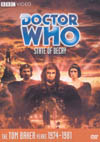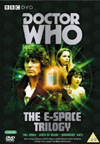DVD Extras include:
This is the last of Terrance Dicks' adaptations of classic horror films for televised Doctor Who, and in my opinion, his most successful. After "King Kong" became "Robot" (story no. 75), Frankenstein became the abysmal "Brain of Morbius" (story no. 84), and the "Thing in the Lighthouse" concept became "Horror of Fang Rock" (story no. 92), the legends of Dracula and vampires find their feet in the Doctor Who universe through "State of Decay".
Triumph of Structure over Subject MatterEven though this subject matter, vampires, is not particularly to my tastes, the story has such an expert traditional structure and an appealing execution of a wider variety of elements in the production that I invariably find myself pulled in and absorbed anyway, and willing to give it high marks and a healthy ranking within the season. Congratulations are due to Terrance Dicks for what I feel is his strongest Doctor Who script after "The War Games" (story no. 50).Notice how expertly the bulk of the early portions of this story stay focused on what I feel is the primary story beat of the science fiction genre - exploration. I'll save my complete dissection of story and plot structure for the In-depth Analysis version of my review, since this version is for those who haven't yet seen the adventure.
Introductory Pros and ConsThe good stuff takes some time to show itself though. After a satisfying establishing shot of the tower and surroundings with barely passable model work, "State of Decay" opens with three very dodgy scenes showing characters going about their usual business. But after a quick shot of the TARDIS traversing the starry green background of E-Space, the script's focus on exploration begins, and the excellence of "State of Decay" sets in.The TARDIS demonstrates itself with a satisfying materialization, and some interesting expository dialogue later on, and the interior / exterior relationship is showcased by the Doctor's liberal movements throughout the story. Nice. With this being the first story shot in John Nathan-Turner's era as producer that features the TARDIS interior, perhaps we have designer Christine Ruscoe to thank for the lovely iconic corrugated pillars hiding the joins between the wall panels. Excellent. This appears to be the second time Ruscoe has updated the TARDIS interior, after working on "Pyramids of Mars" (story no. 82) and leaving a legacy for "Planet of Evil" (story no. 81), which were also shot out of order. "State of Decay" is also blessed with a good amount of location filming (always an enjoyable bonus), although this tends to peter out later in the story after the settings are established and the pace needs to tighten up.
Character LensMany of the guest characters remain blandly forgettable, even after receiving good performances from the actors. It is due to the writing, and this is partly a story point as well, as certain qualities have been bred out of the population. Sadly this leaves the rebels themselves somewhat less than rousing. Nevertheless, Clinton Greyn is quite sympathetic as Ivo, and his larger stature helps him stand out amongst the crowd. Iain Rattray as Chief Guard Habris puts a solidity into his performance that I believe deserves a lot of credit for holding the believability of the whole story together, as the more daring performances of Tom Baker and the ruling trio become more successful by having his on-the-money presence to play off of. Many attempts at similar scenes during the Graham Williams' era fell flat due to hammy or lacking reactions from extra or minor characters, but now Habris goes the correct way and everything works so much better. Good job.Onto the ruling trio, all three get to indulge their passion for acting and get away with being a little weird, and manage to create a villainy unique within the Doctor Who series. That's no small feat. Rachel Davies playing Camilla certainly puts extra into her performance, but Emrys Jones playing Aukon goes for a reverent madness full steam ahead and just manages to avoid going over the top. Tom Baker is clearly enjoying himself in this one, matching Aukon's weirdness when playing opposite him and remaining equally tasteful, but also having barrels of fun exploring all the other characters, locations, and concepts along the way. Lalla Ward catches a bit of the same bug, and does her best work for the story opposite Baker. K9 achieves his best showing for season 18 in this tale, formulaically waiting in the TARDIS at first, but refreshingly taking his rightful turn at fulfilling the traditional function of Doctor's companion later on, and having plenty of action and key things to do during the story's conclusion. His improved mobility actually allows him to be seen exiting the police box for the first (and I believe, only) time. Kudos. Matthew Waterhouse's first performance as Adric (this story was shot before the two preceding ones) is one of his better ones. Adric displays a cheeky confidence in this story, a bit of cunning, and pulls off some nice mischievous, humorous moments with a little help from the musical score. A bit more of this kind of charisma, instead of the "shut-down" Adric he later went for, might have helped keep the wrath of many fan critics off of Matthew's back.
ProductionPaddy Kingsland's first Doctor Who score plays over this story, and is a beautiful and enjoyable achievement. At times humorous, reverent, or boldly underscoring the action, it features his trademark melodic style and lead synthetic flute instrument sound, evoking nostalgia for this period of the show's history. Excellent.The directing, cinematography, and special effects for this story are adequate and enjoyable, but don't stand out all that much. I have a few nits and bones to pick with the design as well, but I'd best save that for the In-depth Analysis version of this review ....and it now looks as though the CGI upgrade crew has sadly left this story as is for the 2009 DVD release. On the plus side, Dave Chapman gets to do justice to K9's laser once again, while some enjoyable original sequences steal the show for special effects during the conclusion.
This story is available on DVD and VHS video as the second adventure of the E-Space Trilogy. Click on the Amazon symbol for the location nearest you for pricing and availability:
Comments on this article are welcome. You may contact the author from this page:
|









